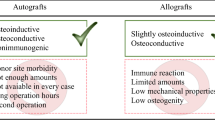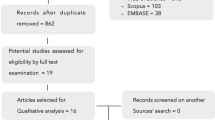Abstract
Glass-ceramic implants containing oxy- and fluoroapatite [Ca10(PO4)6(O, F2)] and β-wollastonite (CaSiO3) were studied under load-bearing conditions in a segmental replacement model in the tibia of the rabbit. A 16-mm segment of the middle of the tibial shaft was resected at a point distal to the junction of the tibia and the fibula. The defect was replaced by a 15 mm-long hollow, cylindrical implant that was fixed by intramedullary nailing using Kirschner wire. The implants were 9 mm in diameter and 15 mm long bearing a central hole 3.05 mm in diameter. The rabbits used were killed 6 months, 1 year, 18 months, and 2 years after implantation. The interface between the bone and the glass-ceramic was investigated by scanning electron microscopy-electron-probe microanalysis (SEM-EPMA).
None of the glass-ceramic implants broke, and the glass-ceramic had bonded directly to the bone tissue without any intervening soft tissue. A calcium-phosphorus layer (Ca-P layer) was observed at the glass-ceramic/bone interface. This layer was 30–100 μm thick at 6 months after implantation, 60–110 μm thick at 1 year after implantation, 80–200 μm thick at 18 months, and 120–350 μm thick at 2 years. At the lateral surface of the glass-ceramic uncovered by the bone, the calcium-phosphorus layer was 50–80 μm thick at 6 months after implantation, 250–450 μm thick at 1 year, 300 ∼ 400 μm thick at 18 months, and 300 μm thick at 2 years. The thickness of the calcium-phosphorus layer increased moderately after long-term implantation. However, it was difficult to estimate the rate of increase in the thickness of calciumphosphorus layer.
Similar content being viewed by others
References
Kokubo T, Shigematsu M, Nagashima Y, Tashiro M, Nakamura T, Yamamuro T, Higashi S (1982) Apatite- and wollastonite-containing glass-ceramic for prosthetic application. Bull Inst Chem Res Kyoto Univ 60:260–268
Nakamura T, Yamamuro T, Higashi S, Kokubo T, Itoo S (1985) A new glass-ceramic for bone replacement: evaluation of its bonding ability to bone tissue. J Biomed Mater Res 19:685–698
Kitsugi T, Yamamuro T, Nakamura T, Higashi S, Kakutani Y, Hyakuna K, Ito S, Kokubo T, Takagi M, Shibuya T (1986) Bone bonding behavior of three kinds of apatite-containing glass-ceramics, J Biomed Mater Res 20:1295–1307
Kitsugi T, Yamamuro T, Nakamura T, Kokubo T, Shibuya T, Takagi M (1987) SEM-EPMA observation of three types of apatite-containing glass-ceramics implanted in bone: the variance of a Ca-P rich layer. J Biomed Mater Res 21:1255–1271
Kitsugi T, Yamamuro T, Nakamura T, Oka M, Kokubo T (1993) Influence of disodium (1-hydroxythylidene) diphosphonate on bonding between glass-ceramics containing apatite and wollastonite and mature male rabbit bone. Calcif Tissue Int 52:378–385
Kokubo T, Kushitani H, Sakka S, Kitsugi T, Yamamuro T (1990) Solutions able to reproduce in vivo surface-structure changes in bioactive glass-ceramic A-W3. J Biomed Mater Res 24:721–734
Kokubo T, Ito S, Huang ZT, Hayashi T, Sakka S, Kitsugi T, Yamamuro T (1990) Ca, P-rich layer formed on high-strength bioactive glass-ceramic A-W. J Biomed Mater Res 24:331–343
Kokubo T (1990) Surface chemistry of bioactive glass-ceramics. J Noncryst Solids 120:138–151
Kitsugi T, Yamamuro T, Kokubo T (1989) Bonding behavior of a glass-ceramic containing apatite and wollastonite in segmental replacement of the rabbit tibia under load-bearing conditions. J Bone Joint Surg 71-A:264–272
Kokubo T, Ito S, Sakka S, Yamamuro T (1985) Mechanical properties of a new type of apatite-containing glass-ceramic for prosthetic application. J Mat Sci 20:2001–2004
Yamamuro T, Shikata J, Okumura H, Kitsugi T, Kakutani Y, Matsui T, Kokubo T (1990) Replacement of the lumbar vertebrae of sheep with ceramic prostheses. J Bone Joint Surg 72-B: 889–893
Yamamuro T, Nakamura T, Higashi S, Kasai R, Kakutani Y, Kitsugi T, Kokubo T (1984) An artificial bone for use as a bone prosthesis. In: Atumi K, Maekawa M, Ota K (eds) Progress in artificial organs-1983, Vol. 2. ISAO Press No. 204, Cleveland, pp 810–814
Kitsugi T, Yamamuro T, Takeuchi H, Ono M (1988) Bonding behavior of three types of hydroxyapatite with different sintering temperatures in bone. Clin Orthop Rel Res 234:280–290
Kitsugi T, Yamamuro T, Nakamura T, Kotani S, Kokubo T, Takeuchi H (1993) Four calcium phosphate ceramics as bone substitutes for non-weight bearing. Biomaterials 14:216–224
Kitsugi T, Yamamuro T, Nakamura T, Kakutani Y, Hayashi T, Ito S, Kokubo T, Takagi M, Shibuya T (1987) Dynamic fatigue test of apatite-wollastonite containing glass-ceramics and dense hydroxyapatite. J Biomed Mater Res 21:467–484
Kitsugi T, Yamamuro T, Nakamura T, Kokubo T (1989) Bonding behavior of MgO-CaO-SiO2-P2O5-CaF2 glass (Mother Glass of A.W.-Glass Ceramics). J Biomed Mater Res 23:631–648
Pilliar RM, Cameron HU, Szivek J, Macnab I (1987) Bone ingrowth and stress shielding with a porous surface-coated fracture fixation plate. J Biomed Mater Res 13:799–810
Author information
Authors and Affiliations
Rights and permissions
About this article
Cite this article
Kitsugi, T., Yamamuro, T., Nakamura, T. et al. Scanning electron microscopy-electron probe microanalysis study of the interface between apatite and wollastonite-containing glass-ceramic and rabbit tibia under load-bearing conditions after long-term implantation. Calcif Tissue Int 56, 331–335 (1995). https://doi.org/10.1007/BF00318055
Received:
Accepted:
Issue Date:
DOI: https://doi.org/10.1007/BF00318055




